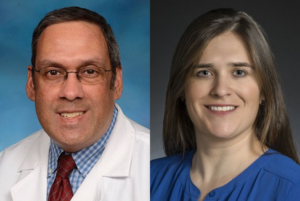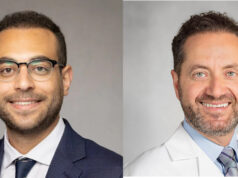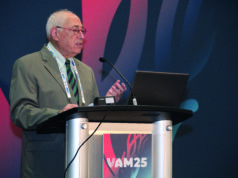
This year’s International Stroke Conference (Feb. 7–9) in Phoenix, Arizona, hosted discussions on the current state of play in carotid stenosis treatment—and, most notably, advances that may erode the dominance of long-established carotid revascularization procedures in the U.S.
Session moderator Larry Goldstein, chair of neurology at the University of Kentucky, Lexington, provided a fitting initial comment on the lack of up-to-date trial data evaluating different carotid disease treatments: “Looking around the room, some of you weren’t even born when these trials were done!”
As Goldstein noted, the trials in question—NASCET in the U.S. and ECST in Europe—were conducted and published some 30 years ago, and only included patients with symptomatic carotid artery stenosis.
“For some of you, this is almost ancient history—but, if you go to our national guidelines, this is all the grade A, level one evidence that we have,” he continued. “When the studies were done, they were internally valid, but time marches on, and things that we thought were true 40 years ago may not be true today.”
Dwindling need for revascularization?
This proved to be an appropriate segue into a presentation from Seemant Chaturvedi, MD, from the University of Maryland School of Medicine, Baltimore, Maryland, who began by stating that things have “dramatically changed” since the advent of those original trials in the 1990s. The succeeding decades have seen well-established medical therapies like antiplatelets, statins, blood-pressure control, physical activity and dietary modification joined by numerous modern options, including proprotein convertase subtilisin/kexin type 9 (PCSK9) inhibitors, inclisiran, bempedoic acid, semaglutide, and combination antithrombotic therapy.
Here, Chaturvedi touched on the various studies that have demonstrated the ability of these newer medications to safely reduce low-density lipoprotein (LDL) levels and ultimately minimize cardiovascular events. Evolocumab—an example of a PCSK9 inhibitor—and inclisiran have been tested and performed well in large-scale trials, while bempedoic acid serves as an alternative for patients who are unable or unwilling to take high-potency statins.
Chaturvedi then somewhat facetiously summarized “all of the data” evidencing the superiority of surgical revascularization over intensive medical therapy for asymptomatic carotid stenosis—presenting the audience with a completely blank slide.
“But, we do have some emerging evidence that, maybe, revascularization is not as good,” he continued, alluding to the fact that carotid endarterectomy (CEA) and medical therapy produced similar outcomes in the SPACE-2 trial, and highlighting the importance of data from the CREST-2 trial, which are expected in early 2026.
“On the symptomatic side, we also don’t really have much evidence that revascularization is much better than modern medical therapy [either]—there hasn’t been a large-scale study since 1991, and so there is a void in the current data,” Chaturvedi added. Once again, he drew attention to the relevance of ongoing studies in the area, including the SCORE registry.
“In 2024, we need to have very intensive medical therapy,” he summarized, also stating there is “no excuse” not to aim for lowering LDL levels to at least <70mg/dl in carotid stenosis patients—as per the target in CREST-2. However, he did note that he aims for LDL levels of <55mg/dl, if not lower, in his own practice. Starting medication alone is “not enough” in modern-day care, Chaturvedi continued, emphasizing the importance of administering treatment with certain goals in mind.
Lipoprotein (a), factor XIa inhibitors, colchicine, and agents that target vascular inflammation, are among additional medications “on the horizon” in carotid disease, according to Chaturvedi, who speculated that the neurovascular community is likely to hear more about each of these over the next 1–2 years.
“There is a plethora of new treatment options which have been proven to be associated with cardiovascular event reduction and, if we’re able to optimally use all of these agents, that should decrease the need for carotid revascularization.”
The third mode
Following this, Caitlin Hicks, MD, a vascular surgeon at Johns Hopkins Medicine in Baltimore, discussed another frontier that appears to have moved alongside CEA and carotid artery stenting (CAS) over the past decade: transcarotid artery revascularization (TCAR). Developed by Silk Road Medical via the Enroute stent system, TCAR’s intended benefits include avoiding the aortic arch, providing proximal protection, and improving particle capture.
TCAR received Food and Drug Administration (FDA) approval in 2015 for use solely in high-risk carotid stenosis patients, but with the caveat that physicians had to contribute clinical data—including perioperative and one-year outcomes—to the Vascular Quality Initiative TCAR Surveillance Project (VQI-TSP) in order to actually gain reimbursement for the procedure.
This has created a greater wealth of both comparative and non-comparative data on TCAR, and studies evaluating it have “exploded” over the past few years as a result, Hicks relayed. Broadly, these studies have suggested TCAR produces stroke/death rates, comparable to those seen with CEA out to one year, across asymptomatic and symptomatic patients alike. Additional studies demonstrating non-significant differences in rates of stroke/death/myocardial infarction between the two—specifically those involving standard-risk patients—ultimately supported an expanded indication of the procedure from the FDA in 2022.
Figures suggest TCAR has “taken off” in the USA over the past few years, with CEA and CAS declining slightly—a trend that is especially pronounced for high-risk carotid stenosis patients, in whom TCAR is now the predominant revascularization approach nationally. Hicks did also acknowledge that the 2023 Centers for Medicare and Medicaid Services (CMS) coverage expansion, under which CAS is no longer limited to certain lower-risk patients, will likely lead to an increased stenting uptake and TCAR “losing ground” in more high-risk patients. However, “on the flipside”, with TCAR also being covered by this expansion, physicians are no longer mandated to contribute to the VQI-TSP database, potentially making the procedure less expensive to accommodate and thus boosting uptake at smaller community hospitals in the USA.
Hicks then noted that “there has been very close oversight of the use of TCAR by industry”—although she feels this is likely to be “unsustainable” in the long term, especially if the procedure continues to expand and is taken up by multiple other specialties. She also highlighted the fact that data on TCAR remain limited, overall, as the majority come from the industry-sponsored ROADSTER studies as well as the VQI-TSP registry, which are helpful indicators of real-world patient outcomes, but certainly not equivalent to a randomized controlled trial (RCT).
“People always call for an RCT comparing TCAR to CEA—and/or transfemoral stenting,” she continued. “As much as I would love to see that happen, it almost certainly will not. It’s not financially viable. Silk Road Medical has seen a large market-share increase, and there’s really no reason for them to fund a study like that. So, unless something like that is funded by the government or another format, this will likely not be in our future.”
Nevertheless, Hicks feels data on longer-term outcomes are needed to help understand “where TCAR fits into our carotid revascularization armamentarium”.
Patient-centric decisions
“Ultimately, I think having patients see physicians that are able to perform all three procedures is probably the best bet, because we can really try to weigh up the risks and benefits, and have patient-specific decision-making,” Hicks commented.
In a subsequent discussion, Thomas Ford, MD, from UMass Memorial Health in Worcester, Massachusetts, said that, while an “ideal world” would see a single proceduralist offer all three of the aforementioned procedures, there is a certain “division of labour” in many centers whereby vascular surgeons often perform the majority of CEAs and TCARs, while interventionists perform a lot of non-invasive procedures like CAS.
Responding to Ford’s question on how best to navigate this, Hicks admitted it is “difficult, for sure”, but that the keys to success are the conversations had between vascular surgeons, interventional neuroradiologists, and stroke neurologists, where necessary.
“I certainly don’t think that there’s a perfect way,” she added. “The new carotid NCD [National Coverage Determination] calls for shared decision-making, with a discussion of all three carotid revascularization options prior to choosing one. There is no current, validated shared decision-making tool to use with patients, so that’s a little bit misaligned with what we have available in the clinical realm—but, I think, as that develops moving forward, at least being able to have a conversation about the three choices and then trying to steer the patient in the right direction is what we all need to aim for.”












